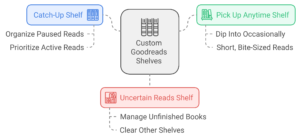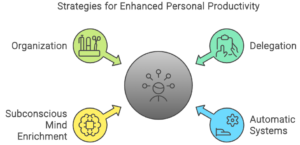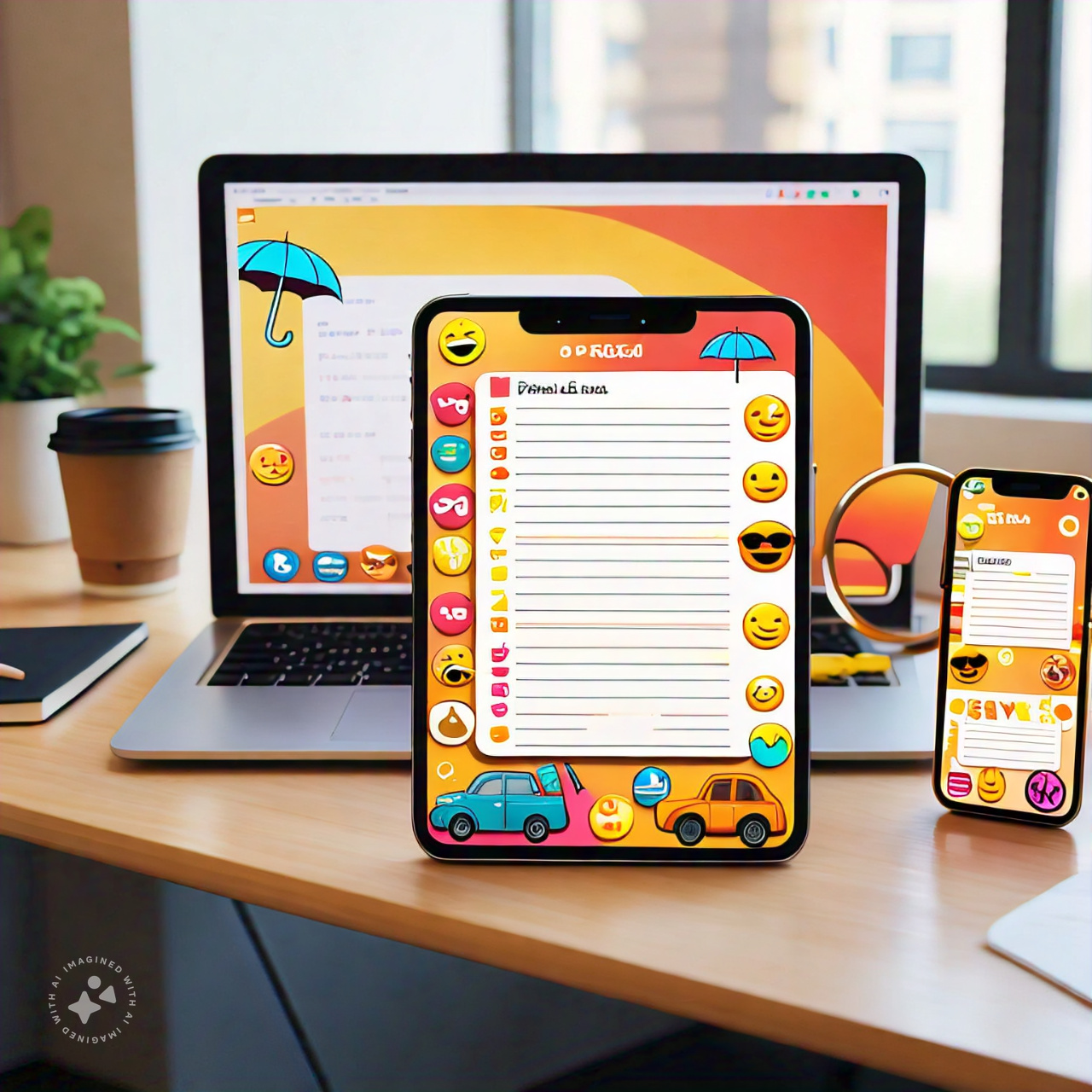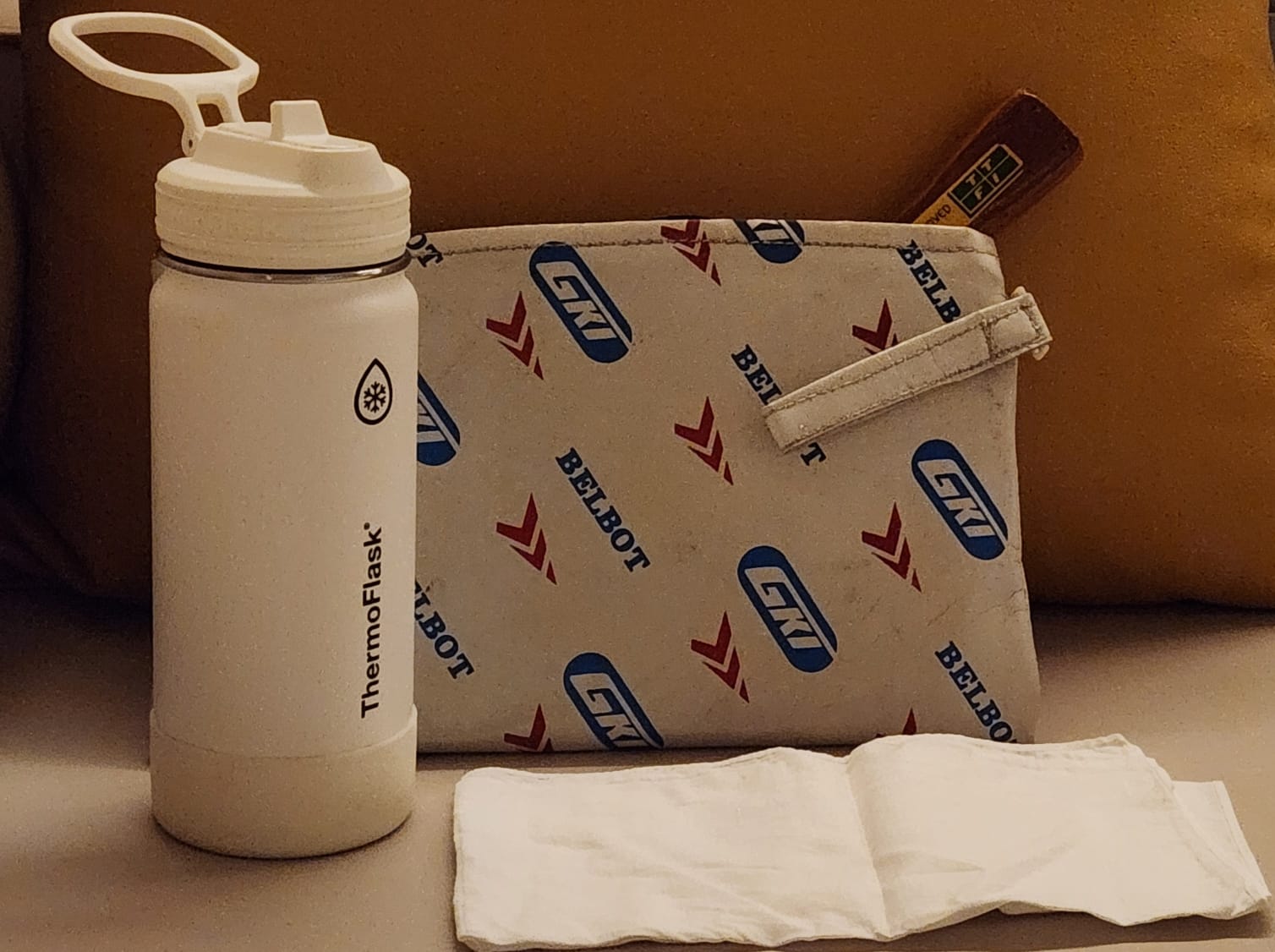🎉Adding Fun and Function: Using Emojis in Your To-Do List📋
In the digital world, emojis have become a universal way to express emotions. What started as simple smiley faces has evolved into a whole language that we now use without even thinking. Emojis have transcended text messages and social media and become part of our everyday communication. In fact, it’s not uncommon to hear people describe feelings using the names of emojis like “heart eyes” or “facepalm.”
Almost every mobile app allows you to sprinkle emojis in your content, whether you’re texting, writing a note, or posting on social media. But desktop apps are catching up fast, with some interesting shortcuts to access emoji panels. If you’re on Windows PC, or on Mac, you can pull up the emoji panel by pressing, respectively:
Windows + . (period)
Control + Command + Space
These panels are not just for casual texts—they’re great for spicing up traditionally dull documents like spreadsheets, Word documents, or even emails.
One particular case where I find emojis incredibly helpful is in my to-do list. Yes, I use emojis in my to-do list, and let me tell you—it adds a whole new layer of character and even functionality to it!
I use a spreadsheet for my tasks, and by adding emojis, I can quickly visualize what each task represents or how I should prioritize it. Here’s how I use emojis in my to-do list:
Numbered Emojis: I often add number emojis (like 🔟 or 1️⃣) to assign a tentative order of tasks. This helps me easily see what needs to be tackled first.
Umbrella Task Emoji ☂️: For larger, more complex tasks with subtasks, I use the umbrella emoji (☂️). It helps me keep an overarching task visible, ensuring it doesn’t get overlooked or deleted until everything is fully completed.
Timer Emoji: For tasks I can knock out during short breaks, I use a timer emoji (⏲️). It reminds me that these tasks are quick wins and can be squeezed in between bigger projects.
Car Emoji 🚗: I use the car emoji (🚗) for tasks that need to be done while I’m out and about, like running errands. It’s a quick visual reminder that these tasks require me to leave my home.
Sunset Emoji 🌅: For tasks I plan to tackle in the evening, I use the sunset emoji (🌅). It helps me organize my day by setting aside activities that are better suited for the quieter hours of the day than spending time during teh day.
And this is just the start—your creativity is the only limit! Emojis can help bring some visual flair to otherwise dull task lists, making the experience of planning your day a little more fun and engaging.
In fact, this idea of adding fun to work isn’t just a productivity hack—it’s grounded in workplace psychology. In the popular business book Fish!, the authors emphasize the importance of having fun at work to boost your energy and feel more engaged. Incorporating something as simple as emojis into your to-do list could be a small but impactful way to make your daily tasks feel less like a chore and more like something you enjoy.
So, why not give it a try? Add some emojis to your next to-do list, and watch how much more energized and organized you feel.
Subscribe to my newsletter, to get tips like this and more, directly in your inbox!
Mastering Goodreads: How to Organize Your Reading with Custom Shelves and Tags
It all started with a conversation that many book lovers can relate to.
AN: “My ‘to-read’ list has started to scare me now!”
RK: “Maintain a spreadsheet. I have a template.”
AN: “Please share it… 🙏”
AN: “Organization isn’t the problem. It’s just that I keep adding way more to my ‘to-read’ list than I manage to complete.”
RK: “Try my template. At least it helps us keep control over what we’re choosing.”
AN: “I think most people use Goodreads though…”
RK: “Yeah, that’s a good idea too. I haven’t tried it yet—felt like I could customize things more with a spreadsheet.”
AN: “It’s easier to keep adding books on Goodreads and tracking dates, ratings, and reviews. It works pretty well, plus all my Kindle reading syncs, and it consolidates highlights. You should check it out.”
RK: “Okay. Let me give it a try.”
After that conversation, I finally dove into Goodreads to see if it could offer me the same level of customization and control I had in my spreadsheet. And guess what? With a little setup and strategic organization, Goodreads not only simplified my reading lists but gave me new ways to stay focused and make sense of my reading journey.
If you’re a reader who loves keeping track of your books, Goodreads is likely your go-to app. But did you know you can do a lot more than just mark books as “read”? By creating custom shelves, using tags, and managing your book lists strategically, you can turn Goodreads into a streamlined, clutter-free tool to keep your reading life in perfect order. In this post, I’ll share how I’ve set up my Goodreads shelves, tags, and reading lists for maximum efficiency and simplicity.
- Install Goodreads for Quick Access
First things first—if you haven’t already, install the Goodreads app on your mobile device. I recommend placing it in a specific location on your home screen where you can easily access it whenever you need. This small habit ensures that your reading life stays top of mind, and it makes updating your shelves or checking your current reads effortless. Whether you’re adding a new book, checking reviews, or updating your progress, easy access to the app helps you stay consistent and organized.
- Goodreads and Amazon Integration: Keep It Clean and Crisp
Since Goodreads is integrated with Amazon, it’s super convenient to track your books, especially if you’re buying through Amazon. You can purchase Kindle books, listen to Audible samples, or buy physical books with just a few clicks directly from Goodreads.
But here’s the key to keeping your Goodreads library clean and organized: Only add books you’ve actually procured to your Goodreads shelves. This means you should avoid cluttering your Goodreads with books you want to read or are still thinking about. Instead, keep those wish-list books in your Amazon lists. Once you buy a book, add it to Goodreads and place it on the appropriate shelf (more on that below). This way, your Goodreads remains focused on what you own and what you plan to read, not a long list of potential reads.
This strategy keeps your Goodreads library clutter-free, with only books that are relevant to your current and future reading. Meanwhile, your Amazon wish list can serve as a repository for books you’re interested in purchasing down the road.
- Creating Custom Shelves to Organize Your Library
Goodreads provides default shelves like “Read,” “Currently Reading,” and “Want to Read,” but I recommend going beyond these basics. Custom shelves allow you to create lists that mirror your reading habits and organizational style.
Here are the custom shelves I use to keep my Goodreads library tidy and purposeful:
- Catch-Up Shelf: This is where I park books that I started but paused. It’s like a holding zone for books I plan to return to. Keeping them in this “Catch-Up” list ensures my “Currently Reading” shelf remains neat, focused, and manageable. If I ever find myself overwhelmed by too many books on my “Currently Reading” list, I simply push some into this Catch-Up shelf. This way, I can prioritize my active reads without losing track of the books I plan to revisit.
- Pick Up Anytime Shelf: These are books I like to dip into on occasion, but they don’t officially sit in my “Read” or “Currently Reading” shelves. Think of these as books that you can enjoy in small, bite-sized readings, like poetry collections or short stories. Whenever I have just a few minutes and want to read something quick, this shelf is my go-to. It’s perfect for those moments when you want to read but don’t have the time or focus for something too long or complex.
 Uncertain Reads Shelf: We all have those books that we start but don’t necessarily plan to finish. Instead of letting them clutter my other shelves, I created this Uncertain Reads shelf. It’s a place for books I’ve tried but am not sure I’ll ever return to. This shelf keeps my “Catch-Up” list clear of books that I’m unlikely to revisit, helping me stay focused on what truly matters.
Uncertain Reads Shelf: We all have those books that we start but don’t necessarily plan to finish. Instead of letting them clutter my other shelves, I created this Uncertain Reads shelf. It’s a place for books I’ve tried but am not sure I’ll ever return to. This shelf keeps my “Catch-Up” list clear of books that I’m unlikely to revisit, helping me stay focused on what truly matters.
By creating these custom shelves, I can easily manage my reading process without feeling overwhelmed by unfinished books or an overly packed “Currently Reading” list.
- Using Tags for Quick Discovery
While shelves offer a broad way to organize your library, tags add an extra layer of organization and specificity. Tags help you easily filter your books by format, genre, or any other custom categories you find useful. Here’s how I use tags to simplify book discovery:
- Media Tags: I use three essential media tags—Audible, Kindle, and Physical—to quickly identify the format of a book. This way, I can decide which book to pick up depending on the situation. For instance:
- Audible: Perfect for audiobooks that I listen to while commuting or working out.
- Kindle: For e-books that I read on my phone or tablet, great for travel or quick, on-the-go reading.
- Physical: You should know that these books are available for reading only at limited locations, like your home or your office
- Genre Tags: Genre tags such as “Mystery,” “Historical Fiction,” “Fantasy,” or “Non-Fiction” are incredibly helpful when deciding what to read next based on your mood. Feeling like a cozy mystery or in the mood for something thought-provoking? Just filter by your genre tags to find the perfect book.
- How to Set Up Your Shelves and Tags
Here’s a simple guide to get you started:
- Creating Custom Shelves: Go to the “My Books” section on Goodreads. On the left-hand side, click “Add Shelf,” name your new shelf, and save it. You can create as many custom shelves as you want based on your reading habits.
- Adding Tags: When adding or editing a book, scroll down to the “Tags” section. Enter the tags that make sense for that book (like “Audible,” “Kindle,” or “Fantasy”) and save them. Later, you can search by these tags to easily find books that match your needs.
Final Thoughts: Make Goodreads Work for You
By combining custom shelves, thoughtful use of tags, and a focused approach to managing your reading lists, you can turn Goodreads into your ultimate reading companion. Whether you’re keeping track of audiobooks, deciding what to read next, or managing a long list of potential reads, this system helps you stay organized and clutter-free.
And remember, Goodreads is about making reading enjoyable, not overwhelming. By keeping only the books you own in Goodreads and parking your wish list on Amazon, you’ll keep your Goodreads account streamlined and easy to manage. Give it a try—install the app, organize your shelves, and let Goodreads work for you!
Subscribe to my newsletter, to get tips like this and more, directly in your inbox!
Mastering the Art of Never Forgetting: The Power of Everyday Mnemonics
For the past five years, my commute has been a thrilling five-foot journey from my ‘office’ to my bed and back—talk about working from-home perks! But it wasn’t always like this. Before, I had commutes ranging from 30 minutes to an hour, depending on where I worked. One of the biggest challenges during those commutes was packing everything in the rush of the morning. Forgetting something meant either suffering through the day or making the frustrating trip back home to grab it.
Luckily, I rarely faced such mishaps, all thanks to a clever Marathi mnemonic I learned as a child: पे रू चा पा पा (which literally means “kiss a guava”). Back then, in Mumbai, as an office-goer was about to leave, his wife would often ask in Marathi, “पेरूचा पापा घेतलास का?” meaning, “Did you kiss the guava?”—which was actually a coded way of asking if he’d packed his Pen, Handkerchief, Keys, Pass, and Wallet.
Of course, as times changed and my needs grew, I had to adapt and expand this mnemonic, even destroying the original pun. At one point, it became this longer version: पे रु चा पै पा घ क च मो सौ टा झि (Pen, Handkerchief, Keys, Wallet, Papers, Watch, Pocket Comb, Specs, Mobile, Socks, Tie, and—of course—the zipper check, **XYZ**!).
The point is, that mnemonics like these are life-savers. With so many things on our minds—household matters, work tasks, and everything in between—it’s easy to forget the essentials. Simple memory aids can be the difference between a smooth day and one full of hiccups.
I’ve always maintained a detailed travel checklist, even with a special section for business trips. However, a written checklist isn’t always practical for short outings or daily routines. You might start with a written list, but over time, it’s much easier to create a mnemonic that sticks.
And it doesn’t have to be funny or punny if that’s not your style. You can get creative with simple mental associations: imagine carrying one item on your head, another around your neck, something in each trouser pocket, and a couple in the sides and inside of your duffle bag, let’s say!
Of course, with tools like ChatGPT around, you can always ask for help in creating mnemonics too! For example, I asked for one to help me remember what to pack for swimming, and it came up with this, which I don’t like very much: “Swimmers Can Glide Through Deep Cool” (S.C.G.T.D.C.):
S: Shorts
C: Cap
G: Goggles
T: Towel
D: Dry clothes to wear after
C: Comfortable shirt
Recently, I started going to a table tennis club on Saturday mornings with friends from my neighborhood. After forgetting to bring my water bottle one day and my racket another, I knew it was time to create a mnemonic for that too. I’m thinking of calling it “3 Whites”—my white water bottle, white racket pouch, and white handkerchief. Now I’m forget-proof on that front!
It’s a strategic battle for us Homo sapiens, tackling the forgetfulness caused by our limited short-term memory – one we can win if we learn how to outsmart it!
Subscribe to my newsletter, to get tips like this and more, directly in your inbox!
(Originally published in Times of India on September 28, 2024)
Swimming: My Secret Weapon for Productivity
Swimming has been my secret productivity tool. I don’t just go to the pool for fun or fitness—it’s where I get some of my best thinking done. But let me start from the beginning. Growing up in Udgir, a small town in the Latur district of Maharashtra, the idea of swimming seemed far-fetched. Latur, known for the devastating 1993 earthquake and its water crisis, even had water brought in by train to help the region. For someone raised in an area plagued by severe water shortages, swimming pools were unheard of, and natural water bodies were scarce.
Despite this, the desire to be in water never left me. I sought out every opportunity to swim, no matter how rare. Some of the best chances came during family visits to our ancestral town, Degloor, in a neighboring district, where a peaceful stream offered the perfect spot to splash around. But my first real swimming lessons came in Wai, a small town near Pune, where my mom’s aunt lived. I’ll never forget the Krishna River, which flows through the town, lined with beautiful ghats. It was here that my brother and I learned to swim using a traditional method—a pair of pajama pants (known as लेंगा) tied at both ends to create a buoyant float. We quickly picked it up, but with few chances to swim back home, it would be years before I swam again.
That chance came when a beautiful open well was built on a friend’s farm in my hometown. After graduation, when I started teaching at a local engineering college, those years were filled with excitement around swimming. Well-swimming is very different from pools with lanes. You often swim in place, enjoying the cool water, but the real thrill was jumping from the motor shed roof—40 feet above—into the deep water below. Those fearless leaps erased any lingering fear of water.
A couple of years later, I qualified for a postgraduate engineering course with top grades and had several solid options, one of which was IIT Bombay. I chose IIT Bombay for many reasons, but one of the unspoken ones was the Olympic-sized swimming pool. I eagerly shared my love for swimming with my friends, though I struggled to name different strokes—I didn’t even know they existed! During my one and a half years at IIT Bombay, I rarely missed a day at the pool. It was here I learned proper breathing techniques and nearly perfected freestyle swimming.
After IIT, my swimming journey continued across cities—first to Hyderabad, then Mumbai, and now Pune. Each place I lived was carefully chosen near a good pool. In Hyderabad, it was Bowenpally, where my kids took their first dips. In Mumbai, I swam at the Sher-e-Punjab Gymkhana and later at the Nahar Amrit Shakti Clubhouse. Sher-e-Punjab had diving boards, a rarity, while at Nahar, I focused on intensive swimming, mastering 800 meters of non-stop laps.
When house hunting in Pune, I was excited to find two pools in the plans for Kalpataru Jade in Baner, one an Olympic-length pool still under construction. While waiting for it to be completed, I’ve been swimming regularly in the smaller but impressive 20-meter pool.
My current swimming routine is all about non-stop, intensive freestyle laps. The point of sharing this long journey is that once you’re in the habit of swimming with your head mostly underwater, only coming up occasionally for air, it can feel lonely during those 45 minutes. Most of the time, you’re staring at the bottom of the pool, with the occasional swimmer passing by—though that’s only on busier days.
I can’t stand idle time, even while walking or at the gym—I always have my Kindle or Audible with me. But swimming offers no such distractions. That’s when I began experimenting with focused thinking in this solitude. With no interruptions, no phone, no ebooks, and no audiobooks, it’s just me and my thoughts.
During those laps, I often work through challenging problems from my job or personal goals. It not only breaks the monotony of endless strokes but also helps me generate solutions, making my time in the water both productive and enjoyable.
If you’re looking for a way to boost both your fitness and focus, I highly recommend taking a dip. You might be surprised at how much clarity you can find beneath the surface.
Subscribe to my newsletter, to get tips like this and more, directly in your inbox!
The Wealth Builder’s Playbook: Let Systems and People Work for You, Not Just You
Ever wonder why the rich seem to keep getting richer while others struggle to make ends meet? The wealthy understand that accumulating wealth isn’t just about earning more money. It’s about making their money work harder and smarter. Instead of simply saving or spending, they invest in opportunities that generate additional income streams, allowing their wealth to grow exponentially. This concept of leveraging money—by investing it in assets, delegating responsibilities, and optimizing systems—is key to their success.
You can apply this same principle to personal productivity by letting systems and people (the more, the better) work for you in parallel while you focus on your core tasks. The goal is to maximize your efficiency and effectiveness by identifying delegation opportunities, strategically timing those delegations, and tracking their progress.
- Know and Track Your Delegations
Just as the wealthy invest their money at the right time to maximize returns, you need to delegate tasks at optimal times. Identify tasks that can be assigned to others and determine the best moment to delegate them. For instance, delegate routine tasks early in the day or week to ensure they are completed on schedule, freeing up your time for more impactful activities.
When we talk about delegations, it’s not just about people working directly under you. It includes anyone involved in delivering the outcomes you’re responsible for. For example, if awaiting client feedback is essential for your project, initiate that communication first thing in the morning. This keeps the feedback process moving while you handle other important tasks. Similarly, address emails that require responses while preparing a presentation so that replies may come in while you continue with other priorities.
Many of us understand the importance of delegation but often miss tracking these delegations or dependencies. Maintaining an inventory of all your delegations helps you stay on top of tasks and follow up with those who might be falling behind. Reviewing this list daily can help you optimize the benefits of their workdays.
- Identify and Create a Cohort of Automatic Systems
Look for opportunities that can enhance your productivity or advance your goals without your active involvement. For instance, consider the simple act of charging your phone. You can work comfortably while your phone charges. Identify similar opportunities where automatic systems can continue operating while you focus on more critical tasks. Automate repetitive processes, use scheduling tools, and implement productivity apps to streamline your workflow and reduce manual effort.
- Learn from How Chefs Produce Quality Dishes Just in Time
Chefs excel in time management, starting complex processes early to ensure everything comes together seamlessly. Why can’t we employ this philosophy in our day-to-day work? Often, we end up with missed tasks and last-minute delays due to a lack of comprehensive planning and organization. Chefs maintain a 100% inventory of their steps and ingredients, ensuring everything is accounted for and prepared in advance. Similarly, maintaining a complete to-do list and organizing your documents and materials meticulously can transform your efficiency. By knowing precisely what needs to be done and when, you can tackle tasks with ease and confidence, just like a chef in a well-orchestrated kitchen.
- Put Your Subconscious Mind to Work
Your mind is a powerful tool that can process information and solve problems even when you’re not actively thinking about them. Feed it with quality knowledge through books, podcasts, or videos. This continuous enrichment plants seeds that your subconscious mind can nurture, leading to insights and ideas that support your goals. Take advantage of downtime or passive learning moments to enrich your mental landscape.
Conclusion

Embracing the principles that drive wealth accumulation can significantly enhance your personal productivity. By strategically delegating tasks, harnessing the power of automatic systems, continuously feeding your subconscious mind with valuable knowledge, and staying organized, you can maximize your efficiency and effectiveness. Remember, just as the wealthy leverage their resources to grow their wealth, you too can leverage systems and people to achieve your productivity goals. Start applying these strategies today, and watch as your personal and professional success grows exponentially.
Subscribe to my newsletter, to get tips like this and more, directly in your inbox!
(Originally published in Times of India on August 31, 2024)
Navigating Your Dreams: How to Manage Multiple Goals Without Overwhelm
Many productivity experts advocate for limiting the number of goals we pursue at any given time. On the face of it the reasoning is sound—focusing on fewer objectives allows us to channel more energy and resources into each one, increasing the likelihood of success. However, for many of us, this approach isn’t always practical. Life doesn’t unfold in a series of neatly organized priorities. We often need to meet professional targets, manage family responsibilities, and find time for personal growth—all simultaneously.
Similarly, essentialism, although great in principle, ends up neglecting this practical reality. It’s often hailed as a pathway to a more focused and fulfilling life. The core idea is straightforward: by concentrating on fewer tasks or goals, we can devote more energy and resources to what truly matters, thereby achieving greater success and satisfaction. Essentialism subtly suggests that limiting our goals is always possible or practical. In reality, the need to juggle multiple priorities is unavoidable.
While the idea of limiting goals might seem appealing, the reality is that having multiple goals is often a necessity, not just a choice. Brad Stulberg, co-author of The Passion Paradox, emphasizes the importance of adding “texture” to our lives through the pursuit of diverse, meaningful activities. According to Stulberg, life’s richness and resilience come not from single-minded focus, but from engaging in a variety of pursuits that collectively contribute to our overall well-being.
Stulberg argues that this texture is what gives life its depth and meaning. Pursuing multiple goals across different domains—whether in our professional careers, personal development, family life, or hobbies—creates a tapestry of experiences that makes life both fulfilling and resilient. For example, while achieving professional success is gratifying, coupling it with personal growth, quality time with family, and hobbies leads to a more balanced and satisfying life. Each goal, though demanding, adds a unique layer to our experiences, enriching our lives in different ways.
Moreover, having multiple goals can act as a safeguard against the risks of focusing too narrowly on one area. If setbacks occur in one aspect of life—be it a career downturn, personal challenges, or a failed project—other areas can provide support and stability, preventing the loss from overwhelming us entirely. This diversification of goals helps ensure that our identity and sense of purpose are not tied to a single pursuit, making us more resilient in the face of adversity.
Additionally, having multiple goals allows us to make incremental progress toward long-term aspirations. Essentialism often overlooks the benefit of taking small, consistent steps towards future ambitions. For example, if you aspire to become an author in ten years, starting to read books on writing and studying the craft today builds a solid foundation for when you eventually focus on writing full-time. By advancing gradually in various areas, we ensure that we are not starting from scratch when the time comes to pursue our long-term goals.
In essence, pursuing a “reasonable” number of multiple goals is crucial for a rich and resilient life. Embracing diverse ambitions not only enriches our experiences but also builds resilience. By spreading our focus across various pursuits and making incremental progress, we ensure that setbacks in one area don’t derail our entire sense of purpose, allowing us to recover and thrive in other aspects of life.
The real challenge, therefore, is not about reducing our goals but about managing them effectively and ensuring they align with our core values.
This is where professional time management becomes vital. Time management isn’t just about squeezing more tasks into our day; it’s about making deliberate choices that align with our values and long-term goals. Mastering this skill allows us to juggle multiple goals effectively without feeling like we’re constantly dropping the ball.
Without a robust system to handle multiple goals, the process can quickly become overwhelming. Managing various objectives can lead to stress and chaos, particularly if there’s no clear strategy in place. The core issue is not the number of goals but the lack of a structured approach, which can result in missed deadlines and fragmented efforts.
To effectively manage multiple goals, it’s crucial to implement a structured approach. Here’s a method to alleviate the overwhelm:
- Maintain a List of Goals: Begin by clearly listing all your goals to get a high-level overview of what you aim to achieve. This list acts as a central reference point, keeping you aware of your objectives. While it’s important to have this list, remember it’s not set in stone. You can adjust and refine it as needed, but avoid making changes impulsively. Instead, ensure any modifications are deliberate and well-considered.
- Break Down Goals Using a Mind Map: Utilize a mind map to break each goal into smaller, actionable steps. This visual tool clarifies the specific actions needed for each goal, helping you to understand and prioritize tasks effectively. Don’t underestimate the importance of this step—it’s crucial for success. Many promising goals falter because we neglect to decompose them into doable actions. By investing time in this process, you ensure every necessary step is identified, reducing procrastination and facilitating progress. Remember, achieving full clarity about your goals is an ongoing process. Expect to revise your mind map multiple times as you advance and gain deeper insights.
- Create and Categorize Task Lists: Transform your mind map into detailed task lists, including all the, identified thus far, granular tasks necessary for each goal. Once you have a comprehensive list, categorize these tasks into what can be realistically achieved in the coming week and what should be placed on a back burner list.
- Use a Back Burner List: The back burner list is essential for managing overwhelm. It contains tasks that are important but not immediately actionable. By placing less urgent tasks here, you can declutter your primary task list and focus on what requires immediate attention. This approach helps maintain clarity and allows you to concentrate on tasks that are feasible within the current or upcoming week.
Organizing your goals and tasks in this manner addresses several common issues:
- Overwhelm: The back burner list mitigates the feeling of being overwhelmed by breaking tasks into manageable chunks.
- Focus: Concentrating on tasks achievable within the week ensures steady progress without spreading yourself too thin.
- Clarity: Breaking down goals into actionable steps and categorizing tasks keeps your efforts aligned and well-organized.
In essence, a trusted time management system is crucial for efficiently navigating multiple goals. By structuring your approach with clear lists, mind maps, and strategic categorization, you can handle numerous goals without succumbing to chaos. This method enables continuous progress across various pursuits while maintaining focus and reducing stress.
Don’t constrain your ambitions just to avoid diluting your focus on what seems most vital. Embrace a multitude of dreams to lead a richly textured life, as this diversity equips you to absorb setbacks and navigate challenges with resilience. By implementing a robust time management system as your backbone, you ensure that you can enjoy the journey itself, rather than viewing it as a mere series of tasks. This approach allows you to savor the process of pursuing your goals, making each step towards achievement a part of a fulfilling adventure.
Subscribe to my newsletter, to get tips like this and more, directly in your inbox!
(Originally published in Times of India on August 17, 2024)







